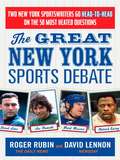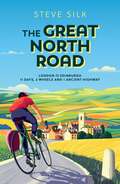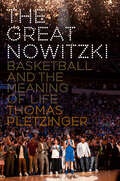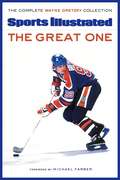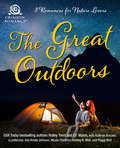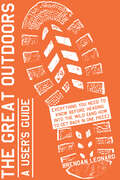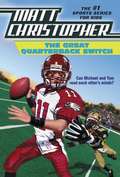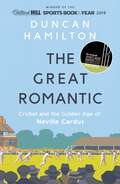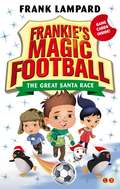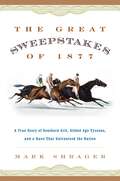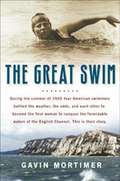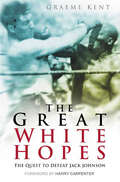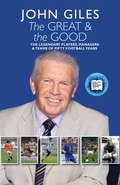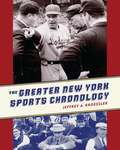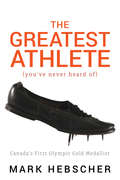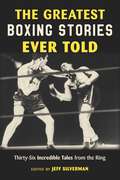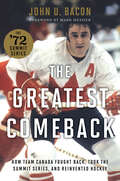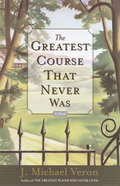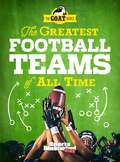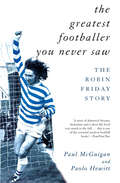- Table View
- List View
The Great New York Sports Debate
by Roger Rubin David LennonTwo top authorities slug it out over the fifty hottest debates in New York sports New Yorkers are notoriously opinionated, and nothing spurs their argumentative side quite like sports. David Lennon of Newsday and Roger Rubin of The New York Daily News- two New York sportswriters, add gasoline to the fire with The Great New York Sports Debate, a "raucous and spirited examination of the fifty most contentious issues in New York athletics. Longtime friends and rivals, Lennon and Rubin engage in heated debate on a wide range of topics, including: * Is George Steinbrenner good or evil?* Which athlete is the biggest villain in New York?* New York's greatest quarterback: Namath or Simms?* Can a New Yorker like "both teams"?Touching on every aspect of New York sports-including baseball, basketball, boxing, and the New York Marathon-The Great New York Sports Debate is guaranteed to spark lively discussion among sports fans everywhere.
The Great New York Sports Debate
by Roger Rubin David LennonTwo top authorities slug it out over the fifty hottest debates in New York sports New Yorkers are notoriously opinionated, and nothing spurs their argumentative side quite like sports. David Lennon of Newsday and Roger Rubin of The New York Daily News--two New York sportswriters, add gasoline to the fire with The Great New York Sports Debate, a raucous and spirited examination of the fifty most contentious issues in New York athletics. Longtime friends and rivals, Lennon and Rubin engage in heated debate on a wide range of topics, including: * Is George Steinbrenner good or evil? * Which athlete is the biggest villain in New York? * New York's greatest quarterback: Namath or Simms? * Can a New Yorker like "both teams"? Touching on every aspect of New York sports--including baseball, basketball, boxing, and the New York Marathon--The Great New York Sports Debate is guaranteed to spark lively discussion among sports fans everywhere.
The Great North Road: London to Edinburgh – 11 Days, 2 Wheels and 1 Ancient Highway
by Steve SilkTravelling by bike at a stately 14 mph, Steve Silk heads north, searching out milestones and memories, coaching inns and coffee shops. The Great North Road is a journey as satisfying for the armchair traveller as the long-distance cyclist. Enriched with history, humour and insight, it’s a tribute to Britain and the endless appeal of the open road.
The Great Nowitzki: Basketball and the Meaning of Life
by Thomas PletzingerA journey into the mindset of a historic basketball superstar, and the importance of his landmark career. The seven-foot Dirk Nowitzki is one of the greatest players in basketball history. The Dallas Maverick’s legend revolutionized the sport, redefining the role of the big man in the modern game. Dirk moved differently: flexible and fast, confident and in control. He thought differently, too. On the court, his shots were masterful—none more venerated than his signature one-legged flamingo fadeaway, a move that lives on in the repertoire of today’s most skilled NBA players. How did this lanky kid from the German suburbs become an all-time top ten scorer and NBA champion? How can a superstar stay so humble? Award-winning novelist and sportswriter Thomas Pletzinger spent over seven years traveling with Nowitzki. He witnessed Dirk’s summer workouts, involving fingertip pushups and the study of the physics, and spent days discussing literature and philosophy with Holger Geschwindner, Dirk’s enigmatic mentor and coach. Watching Nowitzki in empty gyms and in packed arenas with 30,000 fans, Pletzinger began to understand how Dirk and Holger’s philosophical insights on performance, creativity, and freedom enabled his success and longevity. The Great Nowitzki tells Dirk’s dramatic story like never before. Pletzinger describes Dirk’s youth in small-town Germany, follows the steep learning curve of Dirk’s early seasons, the devastating Finals loss to the Miami Heat, and the triumphant championship five years later. Traveling with Dirk in his final seasons, Pletzinger immerses himself in the community of people impacted by Nowitzki’s game, interviewing everyone from average fans in Dallas and security guards at the arena to front office executives and Hall of Fame teammates, who reflect on what Dirk’s career means to the next generation of ballplayers. And to the game itself. A masterpiece of sports writing that reads like a novel, The Great Nowitzki brims with a fan’s passion. Pletzinger shows how strongly basketball influences our imagination and the extraordinary journey an icon like Dirk Nowitzki must take to reach the pinnacle of the game.
The Great One: The Complete Wayne Gretzky Collection
by Sports IllustratedSports Illustrated followed The Great One's career right from the very beginning. Starting in 1978, when Gretzky was a young phenom playing for the Soo Greyhounds, they had their best writers cover his rise to fame and subsequent dominance of the sport. His staggering career stats tend to overshadow the struggles he faced in his career -- the early days in Edmonton, when he was establishing himself as the greatest player, but could not lead his team to a cup. The years after the trade that shook the hockey world he spent years trying to lead a new team to glory, only managing to reach the final once more, in 1993, and losing in five games. Covered as well are his forgotten goal-droughts, the thoughts that he had lost his touch in the early nineties. His struggles with injury and playing though his father's near death. The Great One reads not like a sports book, but a biography of one of the greatest athletes of all time.Sports Illustrated's greatest writers all contribute articles, EM Swift, Michael Farber, Jack Kalla, to tell the complete story of Wayne Gretzky's career.
The Great Outdoors: 8 Romances for Nature Lovers
by Peggy Bird Nicole Flockton Kathryn Brocato Holley Trent Cj Petterson T. F. Walsh Ana Krista Johnson Shelley K WallA value-priced romance collection featuring popular weekend outdoor activities such as camping, hiking, and rafting for nature and fitness fans.Lace up your hiking boots and head out for adventure! Happy trails lead to happy endings for eight star-crossed couples in this digital collection of romances by bestselling and up-and-coming authors. The Cougar’s Pawn: Ellery Colvard agrees to a camping trip with her friends, hoping for a tiny thrill. Instead, she gets carried away—literally—by alpha were-cougar Mason Foye, who needs a mate to avoid his fate. But Ellery has some witchy ways, too, and she isn’t buying into his life story. The clock is ticking as Mason struggles to hold onto his son, his family, and this enchanting woman. Cloaked in Secrecy: Enre Ulf, a former member of the ruling wulfkin clan, plans to infiltrate Alena Novac’s circus clan and take out its alpha to save his home in Transylvania. Except he never expected his wolf claiming Alena as his mate or feeling compelled to save her brother, who was jailed for a murder he didn’t commit. With the police closing in and the blood feud threatening them, Alena and Enre must overcome their pasts to save their packs’ futures. The Look-Alike Bride: Leonie Daniel often stands in for her glamorous older sister, who works as a government agent. All Leonie has to do this time is spend a few weeks at Zara’s lakeside cabin, behave like Zara, and avoid Adam Silverthorne, the man her sister is interested in. But now Adam is falling for Leonie under false pretenses…or is he? Choosing Carter: When Bryn McKay’s brother escapes from prison bent on revenge, she invites her best friend, naturalist and outdoor guide Carter Danielson, on a weekend rafting trip to help her de-stress—and she wouldn’t mind if things turned romantic. But Carter is a recovering alcoholic who shies away from commitment. Then her brother shows up and they must flee for their lives. Will imminent danger prompt Carter to finally figure out where his heart lies? Jade’s Treasure: Booked at a mountain resort under an alias, world-famous author Matthew Riley McLaughlin expects to be left alone to write. Until he meets the charming Jade Sawyer—surely, a bit of pleasure with his business is exactly what he needs. But this plot doesn’t suit Jade’s idea of a good story, especially when she learns their attraction was built on a lie. Matt knows he messed up—but can he create a happier ending to their story? Tangled Vines: Kyle Davis arrives at his Australian ranch for some peace and quiet only to find caretaker Jordan Hastings in his shower. Jordan is trying to get her career as a winemaker back on track by bringing the property’s neglected grapes to life. Falling for a man who controls her employment is not in her plans. Yet the more time they spend together, the more open they become to taking another risk on living and loving. Find Me: Amanda Gillespie never bargained on seeing Jackson Holstenar after their complicated relationship ended with her being asked to leave the law firm where they worked. Now he’s in the weird position of trying to help her become his best pal’s ideal girl. With a little help from fate, these two confused hearts might just find a way back to each other for good. Falling Again: When Fiona McCarthy’s investigative piece and Nick St. Claire’s photography assignment intersect at a mysterious cabin at Mt. Hood National Forest, can their feelings for each other survive her need to get the story and his to frame the perfect shot? Sensuality Level: Sensual
The Great Outdoors: Everything You Need to Know Before Heading into the Wild (and How to Get Back in One Piece)
by Brendan Leonard“Leonard’s durable tome (seriously, the cover is rubber) is stuffed with so many tips about surviving in the wild, you’ll be able to leave your smartphone behind.” —Entertainment Weekly, Best New Books This easy introduction to outdoor life will ensure that even a novice won’t get lost in the woods while finding an activity he loves to do in the great outdoors--whether it’s hiking a 14er or camping on ice. With 400 strategies for engaging in the outdoors, and expert tips and tricks, The Great Outdoors: A User’s Guide makes Mother Nature easier to understand than ever before. Brendan Leonard, writer, filmmaker, and outdoor adventurer, shows the reader how rewarding it can be to live life away from the computer and get outside. From mountain climbing, to skiing, sledding, and sailing, Leonard shows that you don’t need to be a risk taker to enjoy the outdoors. And if the reader does find himself at the point of man vs. nature, Leonard shares survival skills from how to bandage a wound and read a topographical map, to how to drive on sand and remove a tick from your skin—all organized thematically and written in short takeaway entries with helpful line drawings. Bound in a uniquely rugged (and waterproof!) PVC cover material, The Great Outdoors: A User’s Guide is a friendly way into the outdoor lifestyle, whether you're looking to dabble or go all in.
The Great Quarterback Switch
by Matt ChristopherTwelve-year-old Michael, confined to a wheelchair after an accident, uses mental telepathy to communicate football plays to his quarterback twin brother Tom, then suddenly finds himself on the field in his brother's place.
The Great Romantic: Cricket and the golden age of Neville Cardus
by Duncan HamiltonNeville Cardus described how one majestic stroke-maker 'made music' and 'spread beauty' with his bat. Between two world wars, he became the laureate of cricket by doing the same with words.In The Great Romantic, award-winning author Duncan Hamilton demonstrates how Cardus changed sports journalism for ever. While popularising cricket - while appealing, in Cardus' words to people who 'didn't know a leg-break from the pavilion cat at Lord's'- he became a star in his own right with exquisite phrase-making, disdain for statistics and a penchant for literary and musical allusions. Among those who venerated Cardus were PG Wodehouse, John Arlott, Harold Pinter, JB Priestley and Don Bradman. However, behind the rhapsody in blue skies, green grass and colourful characters, this richly evocative biography finds that Cardus' mother was a prostitute, he never knew his father and he received negligible education. Infatuations with younger women ran parallel to a decidedly unromantic marriage. And, astonishingly, the supreme stylist's aversion to factual accuracy led to his reporting on matches he never attended. Yet Cardus also belied his impoverished origins to prosper in a second class-conscious profession, becoming a music critic of international renown. The Great Romantic uncovers the dark enigma within a golden age.
The Great Romantic: Cricket and the golden age of Neville Cardus - Winner of the William Hill Sports Book of the Year
by Duncan HamiltonNeville Cardus described how one majestic stroke-maker 'made music' and 'spread beauty' with his bat. Between two world wars, he became the laureate of cricket by doing the same with words.In The Great Romantic, award-winning author Duncan Hamilton demonstrates how Cardus changed sports journalism for ever. While popularising cricket - while appealing, in Cardus' words to people who 'didn't know a leg-break from the pavilion cat at Lord's'- he became a star in his own right with exquisite phrase-making, disdain for statistics and a penchant for literary and musical allusions. Among those who venerated Cardus were PG Wodehouse, John Arlott, Harold Pinter, JB Priestley and Don Bradman. However, behind the rhapsody in blue skies, green grass and colourful characters, this richly evocative biography finds that Cardus' mother was a prostitute, he never knew his father and he received negligible education. Infatuations with younger women ran parallel to a decidedly unromantic marriage. And, astonishingly, the supreme stylist's aversion to factual accuracy led to his reporting on matches he never attended. Yet Cardus also belied his impoverished origins to prosper in a second class-conscious profession, becoming a music critic of international renown. The Great Romantic uncovers the dark enigma within a golden age.
The Great Romantic: Cricket and the golden age of Neville Cardus - Winner of the William Hill Sports Book of the Year
by Duncan HamiltonNeville Cardus described how one majestic stroke-maker 'made music' and 'spread beauty' with his bat. Between two world wars, he became the laureate of cricket by doing the same with words.In The Great Romantic, award-winning author Duncan Hamilton demonstrates how Cardus changed sports journalism for ever. While popularising cricket - while appealing, in Cardus' words to people who 'didn't know a leg-break from the pavilion cat at Lord's'- he became a star in his own right with exquisite phrase-making, disdain for statistics and a penchant for literary and musical allusions. Among those who venerated Cardus were PG Wodehouse, John Arlott, Harold Pinter, JB Priestley and Don Bradman. However, behind the rhapsody in blue skies, green grass and colourful characters, this richly evocative biography finds that Cardus' mother was a prostitute, he never knew his father and he received negligible education. Infatuations with younger women ran parallel to a decidedly unromantic marriage. And, astonishingly, the supreme stylist's aversion to factual accuracy led to his reporting on matches he never attended. Yet Cardus also belied his impoverished origins to prosper in a second class-conscious profession, becoming a music critic of international renown. The Great Romantic uncovers the dark enigma within a golden age.
The Great Santa Race: Book 13 (Frankie's Magic Football #13)
by Frank LampardFrankie and his team love playing football. There's always time for a game, even when it's Christmas!It looks like it's not going to be a white Christmas for Frankie and his friends. But then the magic football accidentally awakens an evil penguin, who wants to create a snowy winter that will never end! Can Frankie and the team stop him before it's too late for a very special Santa to enter the Great Santa Race?
The Great Sweepstakes of 1877: A True Story of Southern Grit, Gilded Age Tycoons, and a Race That Galvanized the Nation
by Mark ShragerIn 1877 the members of the United States Senate postponed all business for the day so that they might attend a horse race—the iconic, polarizing post-Civil War event at the center of this story. The nation, still recovering from the depredations of the Civil War and the Reconstruction that followed, recognized it as a North vs. South encounter, pitting New York&’s powerful thoroughbred Tom Ochiltree and New Jersey&’s Parole—owned by the ostentatious Northern tycoons Pierre and George Lorrilard—against the already legendary &“Kentucky crack,&” Ten Broeck—owned by the teetotaling, plain-living Frank Harper and ridden by black jockey and former slave William Walker—representing a former slave state and its Southern values. The race and the colorful cast of characters involved reflected the still seething America during one of the nation&’s most difficult and divisive periods. Shrager presents a fascinating and heart-pounding piece of history exposing the racial and economic tensions following the Civil War that culminated in one final race to the end.
The Great Swim
by Gavin MortimerThe dramatic story of the four courageous female swimmers who captivated the world in the summer of 1926. Despite the tensions of a world still recovering from World War I, during the summer of 1926, the story that enthralled the public revolved around four young American swimmers--Gertrude Ederle, Mille Gade, Lillian Cannon, and Clarabelle Barrett--who battled the weather, each other, and considerable odds to become the first woman to conquer the brutal waters of the English Channel. The popular East Coast tabloids from New York to Boston engaged in rivalries nearly as competitive as the swimmers themselves; each backed a favorite and made certain their girl--in bathing attire--was plastered across their daily editions. Just as Seabiscuit, the little horse with the big heart, would bring the nation to a near standstill when he battled his rival War Admiral in 1938, this quartet of women held the attention of millions of people on both sides of the Atlantic for an entire summer. Gavin Mortimer uses primary sources, diaries, interviews with relatives, and contemporary reports to paint an unforgettable portrait of a competition that changed the way the world looked at women, both in sport and society. More than an underdog story, The Great Swim is a tale of perseverance, strength, and sheer force of will. A portrait of an era that is as evocative as Cinderella Man, this is a memorable story of America and Americans in the 1920s.
The Great White Hopes: The Quest to Defeat Jack Johnson
by Graeme Kent Harry CarpenterIn 1908 black fighter Jack Johnson won the heavyweight championship of the world. There was an immediate storm of protest: it was predicted - accurately - that his reign would lead to civic unrest and race riots. Over the next seven years, more than 30 fighters lured by the prospect of fame tried to beat Jackson. This title tells the story.
The Great and the Good
by John GilesIn The Great and the Good, Ireland's leading football pundit and legend of the game John Giles looks back on more than fifty years of football, at developments in the game from the post-War period to the present day, the great players who drove it forward, the visionary managers and their teams, and the age-old question of what makes a player good and what makes one great.From his earliest days, John Giles can recall pondering the subject. 'You'd hear about certain 'great' players, such as Stanley Matthews, but no one would ever explain why they were great. And it's a thing that has always frustrated me: trying to define what makes a player great, and what separates the great from the good.'Now the man himself brings us the answers and celebrates the great ones, from Stanley Matthews, Tom Finney, Dave Mackay, John Charles, Johnny Haynes and Jimmy Greaves to Pele, Franz Beckenbauer, John Robertson, Diego Maradona, Marco van Basten, Lionel Messi, Paul Scholes and many more. It will include a section on Irish players including detailed analysis of such greats as Roy Keane, Liam Brady and Paul McGrath. And, finally, Giles names the player he considers the greatest of them all.
The Great and the Good
by John GilesIn The Great and the Good, Ireland's leading football pundit and legend of the game John Giles looks back on more than fifty years of football, at developments in the game from the post-War period to the present day, the great players who drove it forward, the visionary managers and their teams, and the age-old question of what makes a player good and what makes one great.From his earliest days, John Giles can recall pondering the subject. 'You'd hear about certain 'great' players, such as Stanley Matthews, but no one would ever explain why they were great. And it's a thing that has always frustrated me: trying to define what makes a player great, and what separates the great from the good.'Now the man himself brings us the answers and celebrates the great ones, from Stanley Matthews, Tom Finney, Dave Mackay, John Charles, Johnny Haynes and Jimmy Greaves to Pele, Franz Beckenbauer, John Robertson, Diego Maradona, Marco van Basten, Lionel Messi, Paul Scholes and many more. It will include a section on Irish players including detailed analysis of such greats as Roy Keane, Liam Brady and Paul McGrath. And, finally, Giles names the player he considers the greatest of them all.
The Greater New York Sports Chronology
by Jeffrey A. KroesslerJeffrey A. Kroessler's comprehensive and entertaining time line stretches from the pastoral entertainments of the Dutch to the corporate captivity of professional sports. He chronicles events ranging from the truly heroic to the heartbreaking, from moments of municipal greatness to inescapable social change. Through it all he plants the world of sport at the very center of New York's story. Fully illustrated, The Greater New York Sports Chronologycovers the spectacle of blood sports like bullbaiting to the birth of baseball, the now-forgotten six-day pedestrian contests, and today's New York City Marathon. Alongside great moments like the Mets' "amazin'" World Series win in 1969, Joe Louis's historic bouts with Max Schmeling, Jackie Robinson's breaking of baseball's color line, and Secretariat's remarkable Triple Crown win at Belmont, we encounter the point-shaving scandals of college basketball and the corrupting influence of organized crime in professional boxing. Beyond immortals like Lou Gehrig and Joe Namath, we also find such once well known figures as Joe Lapchick, Marty Glickman, Gertrude Ederle, and Toots Shor. Year by year, this chronology recounts chess matches, America's Cup races, dog shows, golf tournaments, polo matches, tennis games, and more. Kroessler describes the historic venues, boxing arenas, gyms, stadiums, ballparks, and racetracks that have come and gone, yet made New York the undisputed capital of American sport. Witnessing it all, of course, are the greatest fans in the world.
The Greater New York Sports Chronology
by Jeffrey KroesslerJeffrey A. Kroessler's comprehensive and entertaining time line stretches from the pastoral entertainments of the Dutch to the corporate captivity of professional sports. He chronicles events ranging from the truly heroic to the heartbreaking, from moments of municipal greatness to inescapable social change. Through it all he plants the world of sport at the very center of New York's story.Fully illustrated, The Greater New York Sports Chronology covers the spectacle of blood sports like bullbaiting to the birth of baseball, the now-forgotten six-day pedestrian contests, and today's New York City Marathon. Alongside great moments like the Mets' "amazin'" World Series win in 1969, Joe Louis's historic bouts with Max Schmeling, Jackie Robinson's breaking of baseball's color line, and Secretariat's remarkable Triple Crown win at Belmont, we encounter the point-shaving scandals of college basketball and the corrupting influence of organized crime in professional boxing. Beyond immortals like Lou Gehrig and Joe Namath, we also find such once well known figures as Joe Lapchick, Marty Glickman, Gertrude Ederle, and Toots Shor. Year by year, this chronology recounts chess matches, America's Cup races, dog shows, golf tournaments, polo matches, tennis games, and more. Kroessler describes the historic venues, boxing arenas, gyms, stadiums, ballparks, and racetracks that have come and gone, yet made New York the undisputed capital of American sport. Witnessing it all, of course, are the greatest fans in the world.
The Greatest Athlete (You've Never Heard Of): Canada's First Olympic Gold Medallist
by Ron MacLean Mark HebscherCanada's first Olympic gold medallist couldn't walk until he was ten, and became the greatest runner of his generation. Who was the first Canadian to Win an Olympic Gold Medal? When Mark Hebscher was asked this simple trivia question, he had no idea that it would lead him on a two year odyssey, researching a man he had never heard of. Paralyzed as a child and told he would never walk again, George Washington Orton persevered, eventually becoming the greatest distance runner of his generation, a world-class hockey player, and a brilliant scholar. A sports pioneer, Orton came up with the idea of numbered football jerseys and introduced ice hockey to Philadelphia. Orton's 1900 Paris Olympic medals were credited to the United States for seven decades before the mistake was uncovered and rectified. Yet he is virtually unknown in Canada. Finally, his story is being told.
The Greatest Boxing Stories Ever Told: Thirty-Six Incredible Tales from the Ring (Greatest)
"Every once in a while, a book publisher comes up with a great concept for a series of books that deserve more than superficial recognition. Such a series is The Greatest (fill in the blank) Stories Ever Told, anthologies that should win places on many bedside tables. On the long winter nights that lie ahead, such stories make great reading." -The Lexington County Chronicle "THE GREATEST BOXING STORIES EVER TOLD assembles some of the best writing available on the sweet science and illuminates boxing in all its literal and symbolic glory. Each piece in this varied collection connects with the sort of powerful punch one can only expect from the world's greatest writers." -Boxing Digest In THE GREATEST BOXING STORIES EVER TOLD, editor Jeff Silverman delivers a knockout collection of not only the best writing ever penned on the subject of "the sweet science," but also stories that relate to the larger human issues the brutal sport has come to embody. Whether the story be about the triumph of a heroic champion, a tragic death in the ring, the shady tactics of fight promoters, or victories against seemingly impossible odds, each story in this varied collection connects powerfully with the reader. THE GREATEST BOXING STORIES EVER TOLD is the perfect gift for fight fans and non-fight fans alike, and with its allstar lineup of "contenders" throwing "haymakers" and "uppercuts" in every round, it stands as the definitive volume of short stories on this enduring pugilistic pastime.
The Greatest Comeback: How Team Canada Fought Back, Took the Summit Series, and Reinvented Hockey
by John U. BaconThe series you thought you knew: the first book written with the complete co-operation of the whole team“They’ve stolen our beer and our steaks, and then to make it worse when we go back to the hotel after the game, they give us warm, skunky Russian beer and not the good, cold Labatt’s our sponsor sent. I remember thinking, ‘These pricks will never beat us again! They are not going to win another game.’” —Rod Gilbert The Summit Series took place in September 1972, when Cold War tensions could not have been higher. But that was the whole point of setting up this unprecedented hockey series. Team Canada, featuring the country’s best players—all NHL stars, half of them future Hall of Famers—would play an eight-game series, with four games played across Canada followed by four in Moscow. Team Canada was expected to crush their untried opponents eight games to zero, with backups playing the last four games.But five games into the series, they had mustered only one win against a tie and three stunning losses. With just three games left, Team Canada had to win all three in Moscow—all while overcoming the years of animosity and mistrust for one another fostered during the Original Six era. They would also have to overcome the ridiculous Russian refereeing that resulted in stick-swinging fights involving the players, a Canadian agent and Soviet soldiers; surmount every obstacle the Soviets and even the KGB could throw at the players and their wives; invent a hybrid style of play combining the best of East and West, one that would change the sport more than any other factor before or since; and win all three games in the last minute. And they did it all. The Summit players asked Bacon to tell their story and provided unparalleled access and candour in dozens of interviews with almost every living player. The Greatest Comeback is a universal story about overcoming bitter feuds to forge a hard-earned team spirit and inspire heroics against long odds and almost inhuman pressure—an experience so unforgettable that every member of Team Canada considers those eight games to be the highlight of their storied careers.
The Greatest Course That Never Was: A Novel
by J. Michael VeronWhen Charley Hunter first discovered the astonishing golfing prodigy Beau Stedman inThe Greatest Player Who Never Lived, he broke the biggest story in golf history. But now, just as Charley is settling down into his budding legal career at a prestigious Atlanta law firm, strange notes clipped to obituaries start to arrive. Curious as to their origin, he tracks down the sender–an old caddie from Augusta National named Moonlight McIntrye–and Charley finds himself drawn into another tangled mystery surrounding a hidden golf course. Driven by his passion for the game and a hunger for the truth, Charley dives into the most riveting, high-stakes mystery yet, another terrific golf story that will entice and delight fans and newcomers alike. Join Charley and Moonlight in their search forThe Greatest Course That Never Was.
The Greatest Football Teams of All Time: A Sports Illustrated Kids Book (The G.O.A.T. Series)
by The Editors of Sports Illustrated KidsCovering individual teams (Hello, 1972 Miami Dolphins!) but also the best eras in famous teams’ history, such as the Patriots of the ’00s and the Steelers of the late 1970s, the editors at Sports Illustrated Kids dissect the best of the gridiron to show the whys and hows of team building, brilliant strategy, player combinations, and that special magic that the greatest teams have and which owners can’t buy—even if there weren’t a salary cap. Player profiles, stats and records, and thrilling narratives show the march to the Super Bowl and into history of America’s favorite spectator sport. Amazing photos, insider stories, and fun facts capture the cultural phenomenon that is football in the U.S.! The SI Kids editors won’t forget college ball! Picture the 2001 Miami Hurricanes cruising to the national title with a perfect season that was fun and full of swagger, displaying an absurd level of talent with six first-team All-Americans leading the way.
The Greatest Footballer You Never Saw: The Robin Friday Story
by Paolo Hewitt Paul McGuiganRobin Friday was an exceptional footballer who should have played for England. He never did. Robin Friday was a brilliant player who could have played in the top flight. He never did. Why? Because Robin Friday was a man who would not bow down to anyone, who refused to take life seriously and who lived every moment as if it were his last. For anyone lucky enough to have seen him play, Robin Friday was up there with the greats. Take it from one who knows: 'There is no doubt in my mind that if someone had taken a chance on him he would have set the top division alight,' says the legendary Stan Bowles. 'He could have gone right to the top, but he just went off the rails a bit.' Loved and admired by everyone who saw him, Friday also had a dark side: troubled, strong-minded, reckless, he would end up destroying himself. Tragically, after years of alcohol and drug abuse, he died at the age of 38 without ever having fulfilled his potential. The Greatest Footballer You Never Saw provides the first full appreciation of a man too long forgotten by the world of football, and, along with a forthcoming film based on Friday's life, with a screenplay by co-author Paolo Hewitt, this book will surely give him the cult status he deserves.
